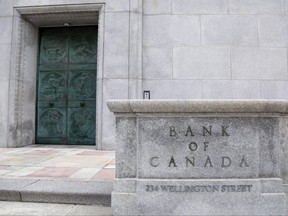
Article content
Canada’s economy shrank in the fourth quarter of 2023 by 0.2%. That’s the second quarter of shrinkage in a row. In the third quarter, it fell 0.3%.
Advertisement 2
Article content
Technically that means Canada is in recession, since the definition of a recession is two consecutive quarters of Gross Domestic Product shrinkage. Yet no one in the government or over at the toady Bank of Canada will use the “R” word.
Article content
To make matters worse, several bank economists have pointed out that, if the rapid growth of immigration is factored in, Canada’s per capita GDP has declined by nearly 5% in the last year.
Per capita GDP — a country’s total value of goods and services divided by its population — is a good indication of its standard of living. And by that measure, Canadians’ standard of living is falling.
Also, as Statistics Canada pointed out on Tuesday, Canada was saved from an even steeper decline only by government spending.
Article content
Advertisement 3
Article content
That is not a good thing. Governments (most of the spending is federal) cannot continue to increase spending without also jacking up taxes, because only working Canadians and businesses create taxable income. The government has little money of its own to sustain artificial economic increases.
Meanwhile, the Americans’ GDP grew more than 5% in the third quarter and by 3.3% in the fourth.
While we are in a recession no one wants to admit, the Americans are in a boom — a mild one, but a boom nonetheless.
Canada and the U.S. have similar inflation rates and unemployment rates. Rents and mortgage payments in both countries have risen substantially in the past year (and by similar amounts), although the effects are being felt differently, because American housing prices and rents were so much lower than ours to begin with.
Advertisement 4
Article content
RECOMMENDED VIDEO
America’s housing inflation has made the affordable market for homes slightly tighter, while Canada’s housing price increases have made already unaffordable homes even more so.
Still, it is unusual for our two countries’ economies to be so out of sync on growth. And they will likely remain out of sync for the rest of 2024.
American growth is projected to be somewhere between 2% and 3% in the coming year. Meanwhile, last week Bank of Canada Governor Tiff Macklem admitted, “Right now growth has stalled. It stalled around the middle of last year. We expect growth to continue to be close to zero,” through the whole of 2024.
That would make six consecutive quarters of no growth or decline.
How is it that there is such a noticeable gap between Canadian and American growth rates? We are seldom so far behind our largest trading partner, if only because when the Americans are doing well they buy more of our goods and services. That helps our economy grow, too.
Advertisement 5
Article content
So, why the shortfall this time?
The answer has to be Liberal government policies on the environment, interest rates, housing, hobbling the energy industry, immigration and more.
Whatever the problem, the Liberal “solution” almost always makes matters worse. That’s because they know more about fashionable woke fads than economics.
The idiocy of their approach to housing and immigration is obvious. The market is building housing for about 300,000 new families a year, while the Liberals are giddily admitting well over one million immigrants, refugees and foreign students.
Or look at the Trudeau government’s approach to food inflation. Rather than, for instance, taking the carbon tax off food production and transportation, or enabling more competition among grocery store chains, the Liberals’ solution has been to try to command an end to higher prices.
Is it any wonder with the current group of economic illiterates in charge that investment in Canada has fallen, along with our productivity and standard of living, while taxes and inflation have skyrocketed?
Article content
GUNTER: Trudeau Liberals' policies causing Canadian economy to lag - Toronto Sun
Read More
Comments